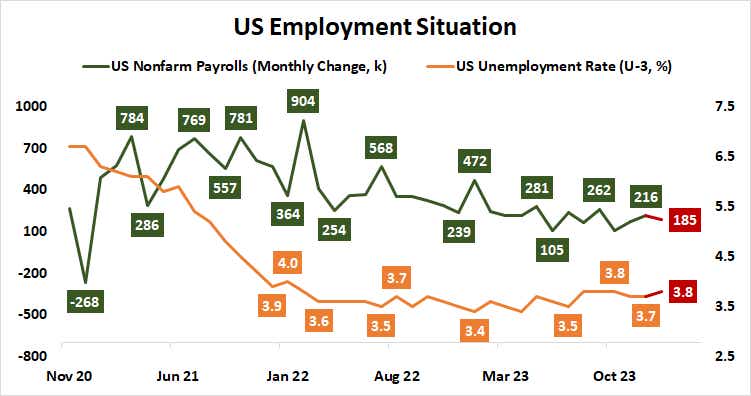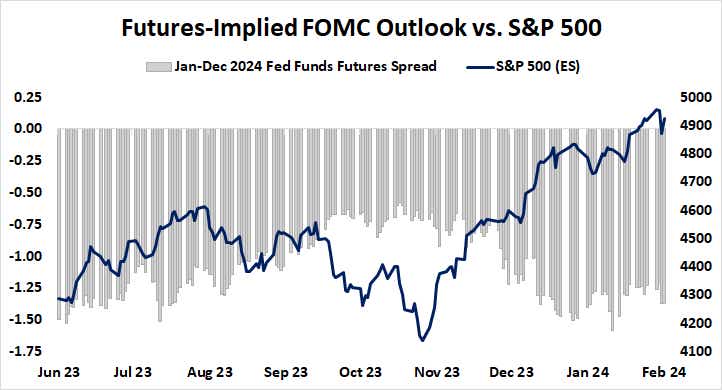U.S. Jobs Report May Hurt Stock Markets as Fed Rate Cut Hopes Unravel

U.S. Jobs Report May Hurt Stock Markets as Fed Rate Cut Hopes Unravel
By:Ilya Spivak
Stocks may face downward pressure even if January’s much-anticipated U.S. employment data prints in line with middling expectation—and an upside surprise might make it worse
- Wall Street has managed to stop the bleeding after the Fed pushed back on rate cut hopes.
- All eyes now turn to January’s U.S. jobs report, where expectations point to middling results.
- Outcomes in line with or better than consensus forecasts may put stocks back on defense.
Shellshocked U.S. equity markets have managed to stagger back to their feet the day after a hawkish Federal Reserve monetary policy announcement handed the bellwether S&P 500 stock index its biggest one-day loss in almost five months.
Fed Chair Jerome Powell pushed back on traders’ ultra-dovish rate cut bets, as expected.
The spotlight now turns to January’s much-anticipated U.S. employment data. Analysts anticipate middling results ahead of the release. A stable pace of job creation in recent months means the expected addition of 185,000 jobs to nonfarm payrolls would line up almost exactly with the 3-, 6- and 12-month trend averages.

The unemployment rate is expected to edge a bit higher to 3.8%, a rise from 3.7% in the previous month. Here too, the result would register squarely within the narrow 3.4-4.0% range of outcomes recorded over the past two years. Analysts expect growth rate of average hourly earnings—a measure of wage inflation—to hold steady at 4.1% year over year.
U.S. employment data: nothing to see here?
The key question for traders is what such familiar outcomes might mean for price action.
Results so closely aligned to a familiar status quo might have little scope for market-moving influence. That's because the economic backdrop they describe has almost surely found its way to being priced into asset valuations.
As ever, contextualizing the data within the markets’ latest thinking is where the investors might find the potential for fireworks. Investors learned this week their baseline assessments of the economic backdrop and that of the Fed come to different conclusions on the way forward for interest rates, with painful results.

Employment data that registers broadly in line with forecasts may thus reinforce the Fed’s resistance to a rate cut at the next meeting on March 20, even as it highlights that the markets’ stimulus hopes are still over-extended. Fed funds futures are pricing in five 25-basis-point (bps) cuts in 2024. Fed officials have projected three of them.
Stocks vs. U.S. labor market: more jobs is … bad?
An upside deviation from forecasts may complicate things further. Analytics from Citigroup show realized results on U.S. economic data have tended to outperform relative to baseline forecasts by a growing margin in recent weeks. This implies surprise risk is tilted toward better-than-expected results.
Taken together, this might amount to a toxic backdrop for Wall Street. With jobs data in the rearview mirror and a quiet economic calendar next week, there may be little left for traders but to digest the Fed’s guidance and dial back risk-taking accordingly. That could weigh on stocks while the U.S. dollar continues to recover.
Ilya Spivak, tastylive head of global macro, has 15 years of experience in trading strategy, and he specializes in identifying thematic moves in currencies, commodities, interest rates and equities. He hosts Macro Money and co-hosts Overtime, Monday-Thursday. @Ilyaspivak
For live daily programming, market news and commentary, visit tastylive or the YouTube channels tastylive (for options traders), and tastyliveTrending for stocks, futures, forex & macro.
Trade with a better broker, open a tastytrade account today. tastylive, Inc. and tastytrade, Inc. are separate but affiliated companies.
Options involve risk and are not suitable for all investors. Please read Characteristics and Risks of Standardized Options before deciding to invest in options.